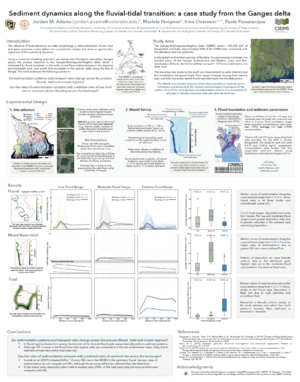2019 CSDMS meeting-005
Log in (or create account for non-CSDMS members)
Forgot username? Search or email:CSDMSweb@colorado.edu
Browse abstracts
Sediment dynamics along the fluvial-tidal transition: a case study from the Ganges delta

The influence of hydrodynamics on delta morphology is well-understood: fluvial, tidal and wave processes sculpt deltas into characteristic shapes that serve as geomorphic signatures of the underlying dynamics. This work examines how complex interactions between major rivers and tides influence the dendritic, island-dense morphology of the Ganges-Brahmaputra-Meghna Delta (GBMD). In the uppermost delta plain, fluvial processes dominate. Moving downstream, tides begin to interact with fluvial dynamics in a “mixed” process zone. Near the terminus of the GBMD in the Bay of Bengal, tidal processes take over, particularly in the western, abandoned lobes of the delta. This work focuses on how sediment transport and floodplain deposition patterns and rates change along that process transition. Using geomorphic metrics such as island area, aspect and channel sinuosity within new machine learning techniques, we resolved areas of the delta that display similar process signatures. Ideal island cases were selected from several zones across the fluvial-tidal transition. Using Delft3D, we modeled the patterns of geomorphic change that result from multiple flood ranges (low, medium and extreme) and sediment cases (-50%, average +50% suspended sediment concentration of 4 cohesive grain classes). Preliminary results indicate floods can deposit 2 – 3 cm of sediment per year across the delta, albeit in distinct patterns due to local differences in hydrodynamic processes. By using this highly-resolved nested model approach, deposition rates can be upscaled to estimate the amount of sediment being reworked within the individual process zones. The results obtained can then be used to illustrate how the different hydrodynamic zones contribute to the large-scale evolution of the delta, and explore how the system will respond to predicted global sea level rise over the next century.
